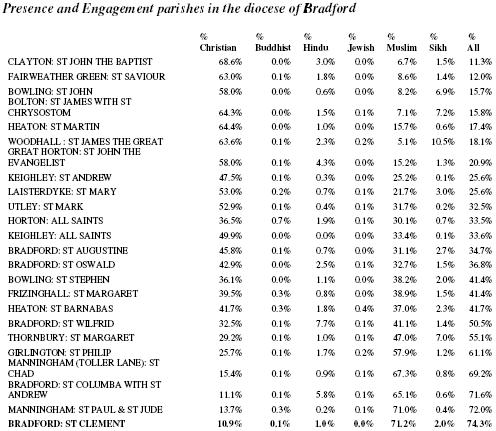Thus the headline in today’s Daily Telegraph. The recommendation by the Church of England’s Dioceses Commission that three dioceses in the Yorkshire area should be merged into one was flagged up well in advance. This issue has already been hammered to death by the Mail on Sunday back in October followed by the Daily Express and the Daily Star (see the response by ENGAGE).
Still, you can never have too many scaremongering articles about the Muslim threat to Christian civilisation, can you?
Elsewhere in the Torygraph, under the heading “A tipping point for religion in Britain?“, the Sunday Telegraph‘s Religious Affairs and Media Correspondent, Jonathan Wynne-Jones, tells us that it is
difficult not to see the merger – or axing depending on which way you’re looking at it – in the context of the rise of Islam in Britain. In Bradford, one of the dioceses that is being subsumed, Muslims make up as much as three-quarters of the population in some parishes.
A report published by the Church earlier this year discussed the issues facing clergy trying to minister in areas with high numbers of ethnic minorities. It revealed the percentage of Christians is as low as 10 per cent in some parishes.
When Michael Nazir-Ali, the former Bishop of Rochester, warned of “no-go areas” in Britain for non-Muslims, he was widely ridiculed and criticised, but the Church’s report suggests that his critics have their heads in the sand. Bleak and rather extreme it may have been, but statisticians have already predicted that by 2035 there will be more active Muslims in Britain than church-going Christians.
The claim that “Muslims make up as much as three-quarters of the population in some parishes” in Bradford is clearly an exaggeration. There is no parish in Bradford where the Muslim population reaches that figure, and there are just two parishes in which Muslims make up over 70% of the population (see below). With regard to the UK as a whole, to put Wynne-Jones’ claim that “the percentage of Christians is as low as 10 per cent in some parishes” in proportion, the CofE report that he cites, Sharing the Gospel of Salvation, found that there are only 1,000 parishes, out of a total of 13,000, in which more than 10% of people are of non-Christian faiths. Among these 1,000 parishes, the report identified one in Leicester where the Christian population was 10.8% and one in Bradford where the figure was 10.9%. As the tables below illustrate, the two parishes were hardly typical, even of these two cities with their untypically large populations of South Asian origin:

Wynne-Jones writes that “statisticians have already predicted that by 2035 there will be more active Muslims in Britain than church-going Christians”, but the key phrases here are “active Muslims” and “church-going Christians”. Even if you accept the statistical analysis in the 2008 Christian Research Religious Trends report that Wynne-Jones cites (and the CofE dismissed its findings as “flawed and dangerously misleading”), the report stated that there were only 1.6 million Muslims living in Britain today compared with 41 million Christians. By 2035, Christian Reseach predicted, there would be 1.96 million active Muslims in Britain, compared with 1.63 million church-going Christians. So, if the number of active Muslims in the UK were to exceed the number of active Christians, then that would be primarily due to a decline in the number of Christians who practise their faith, rather than because there had been a dramatic increase in the number of Muslims.
As for Nazir-Ali’s disgraceful nonsense about “no-go areas”, he defined them as areas in which “a strict Muslim ideology” prevails and consequently “people of a different race or faith face physical attack”, although it was notable that he failed to specify where these areas were to be found. That was bad enough, but Wynne-Jones’ position is even worse. What he appears to be arguing is that non-Muslims face the threat of violent assault not just in areas supposedly dominated by “a strict Muslim ideology” but in areas where “active Muslims” outnumber church-going Christians. The CofE’s Sharing the Gospel of Salvation report of course suggested nothing of the sort, and its authors would undoubtedly be appalled to have their research misrepresented in this way.
See also the comments by ENGAGE.
